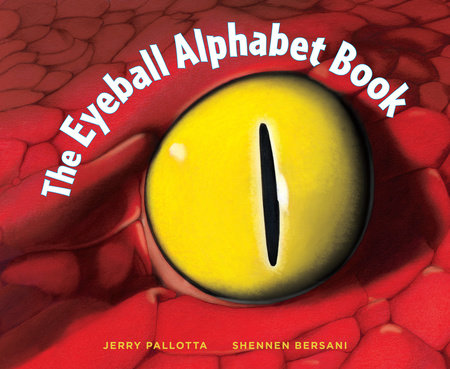Best-selling author Jerry Pallotta takes a peek at eyes from across the animal kingdom in this hilarious and fact-packed alphabet book.The eyes have it! Laugh as you learn by staring right into the eyes of familiar animals (
A is for
alligator eye) and not-so-familiar ones (
Z is for
zebu eye!). Readers of all ages will be entertained with every page turn. Language learning bonus: each page defines an idiom that includes the word "eye"!
Jerry Pallotta is the author of more than twenty alphabet books, including
The Crab Alphabet Book, The Sea Mammal Alphabet Book, The Icky Bug Alphabet Book, The Butterfly Alphabet Book, and
The Beetle Alphabet Book, as well as more than twenty math books, a holiday series, an early-reader series, and a US military series.
Shennen Bersani is the author and illustrator of
Achoo! Why Pollen Counts. She has also illustrated many books for children, including
Butterfly Colors and Counting and
Ocean Counting: Odd Numbers;
Astro: The Steller Sea Lion;
Sea Slime and
It's Eeuwy, Gooey and Under The Sea; and
Icky Bug Shapes.
The eyes have it in Pallotta’s latest playful and informative ABC.
Bersani follows up the spectacular illustrations in
Not a Butterfly Alphabet Book (2019) with another set of equally bright, bold, and this time literally eye-catching close-ups to go with Pallotta’s alphabetical assortment of ocular animal facts. Pallotta offers specific observations on the eyesight of creatures from giant squid to spider while also contrasting the general benefits of monocular and binocular vision, describing three types of tears, and casting glances at other vision-related facts, such as a fly’s compound eyes and a python’s thermal sensors. Both author and illustrator tuck in extras, including, for each letter, a thematically related figure of speech like “get some shut-eye” and “to see eye to eye” and a gallery of goofy eyeglasses, and they occasionally dart off topic (“N” is represented by “Night Crawler,” for instance: “They never need to visit an eye doctor!”). The statement that “having no eyesight is called blindness” may be glaringly simplistic, but that’s an isolated blink in a generally illuminating overview. A bulleted list of savvy advice for proper peeper care at the close is worth taking a gander at.
Occasionally loses focus but rich in eye-opening facts and eye-candy art.
—
Kirkus Reviews Did you know that horses have oval-shaped pupils and lobsters can only see light and dark? Or that earthworms, widemouth blindcats, and yeti crabs have no eyes at all, and ostriches have the largest eyes of any land mammal? This book presents alphabetical eyeball facts as well as a breakdown of idioms, from “the eye of the beholder” to “in the blink of an eye.” This is the latest in a successful series of alphabet books and another nonfiction collaboration by Pallotta and Bersani. The choice to highlight lesser known, unique animals like an indri, quoll, tarsier, uakari, xenosaur, and zebu is fresh and inspiring, and Bersani’s almost photorealistic artwork uses stunning close-ups and intriguing angles. While perhaps not every child will be itching to learn about the difference between binocular and monocular vision or a camel’s nictitating membrane, the wild popularity of the Who Would Win? series will certainly drive an audience for this book. Find Steve Jenkins’
Eye to Eye and Shelley Rotner’s
Whose Eye Am I? for an eye-catching display.
—Booklist

















